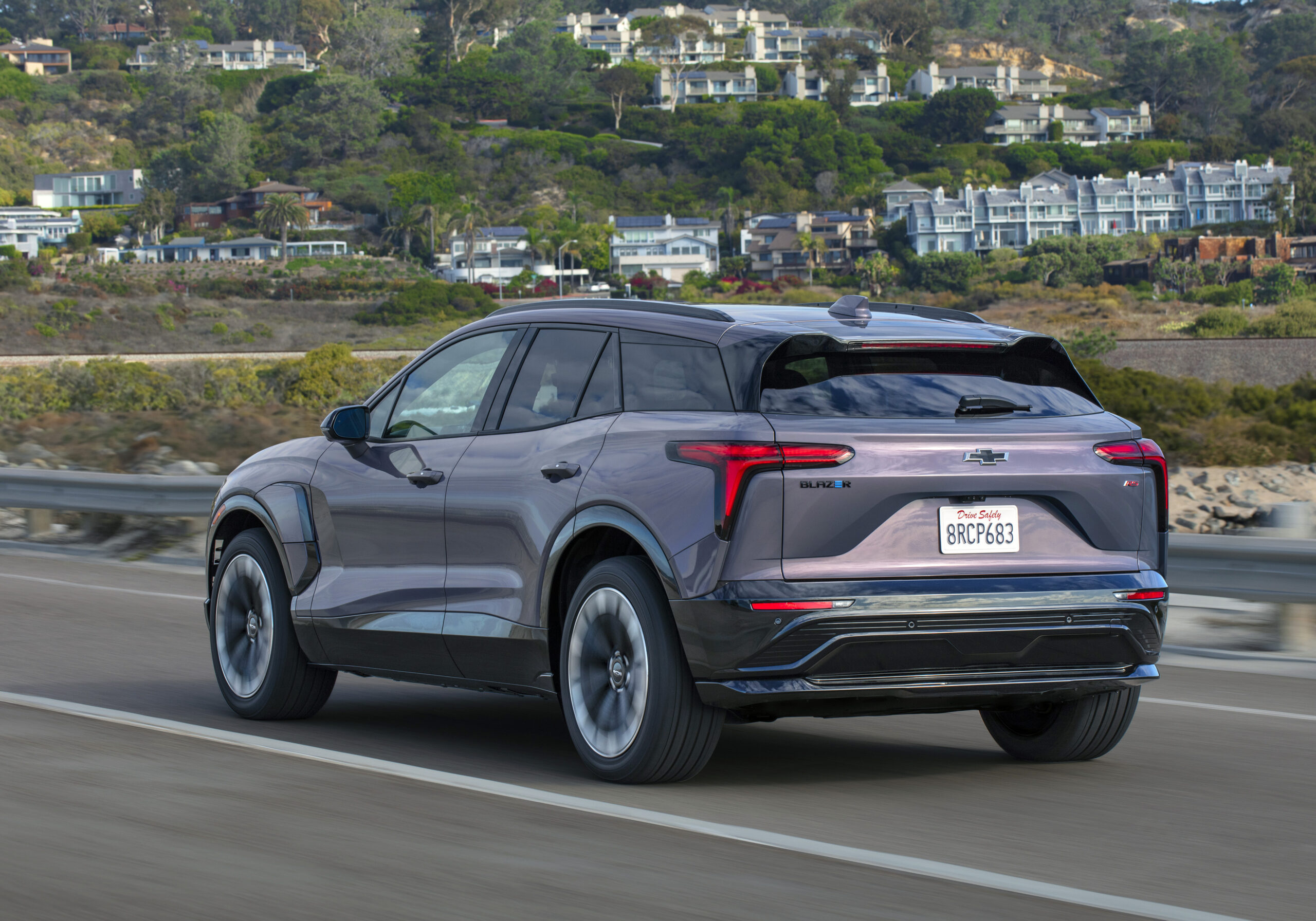But Here’s Our First Look, Anyhow
Software problems have halted sales
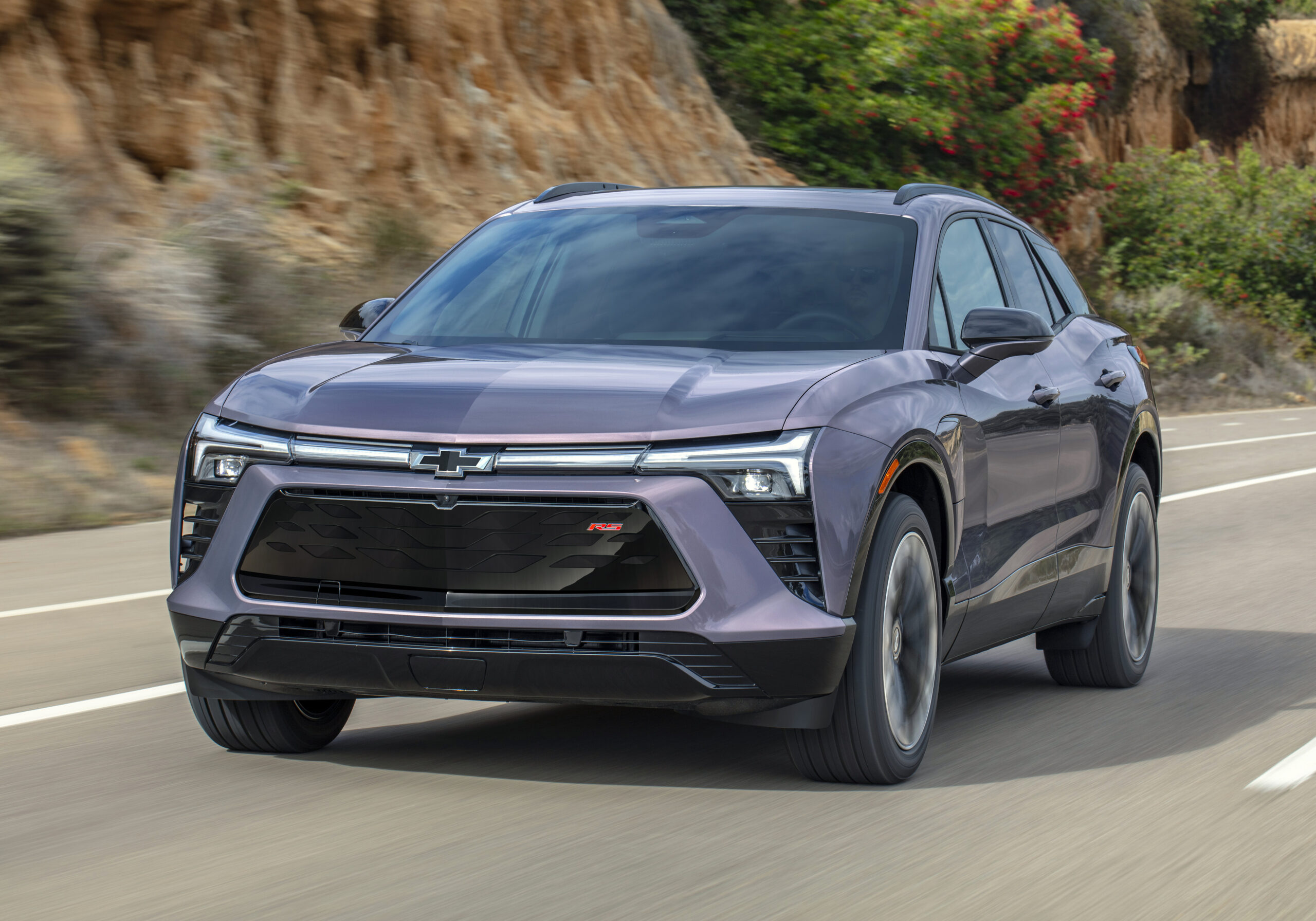
Chevrolet has issued a stop sales order on the new 2024 Chevy Blazer EV in the wake of a series of major software glitches, mostly affecting the infotainment operate system which, as in many new vehicles these days, controls many of the vehicle’s essential functions.
In several cases, Blazer EV batteries would not charge.
There’s no word on when the sales hold might be lifted.
Chevrolet says the software issues are not safety related and affect only a limited number of vehicles, but has ordered the sales stop out of an abundance of caution. The issues are not connected to General Motor’s Ultium platform and battery system for EVs, or to the Google Built-In infotainment software, according to a statement released by the automaker.
“We are aware that a limited number of Blazer EV owners have experienced several software quality issues,” Scott Bell, VP of global Chevrolet, said in a statement. “Customer satisfaction is our priority and as such, we will take a brief pause on new deliveries.”
GM reports sales quarterly, so we’ve no clue as to how many Blazer EVs are already in owner’s hands. Deliveries began in early August and for the third quarter ending Sept. 30 the automaker reported sales of just 19 of the new electric SUV.
A GM spokesman told thegreencarguy that Blazer EV owners who’ve already taken delivery will be notified when the software fix is ready and can drive their vehicles until then.
And Now, Our BLAZER EV DEEP DIVE
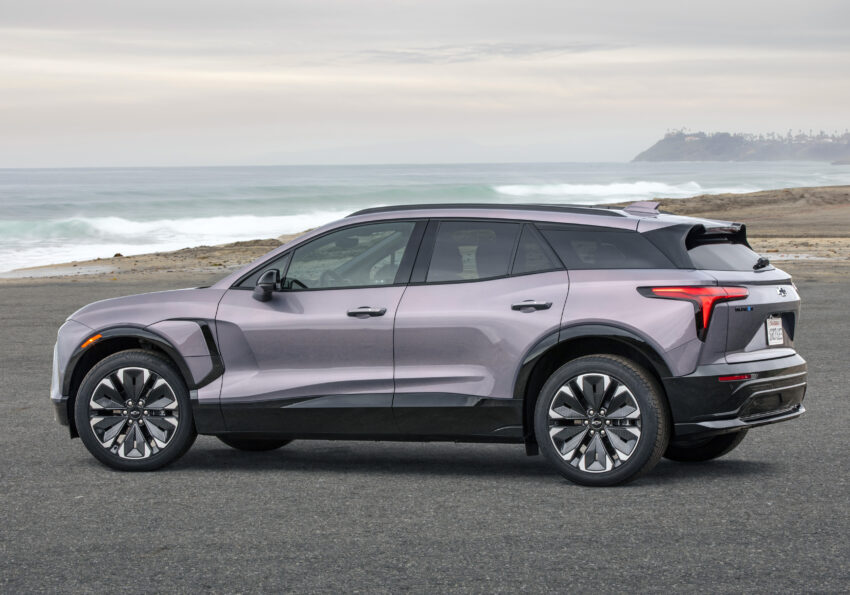
Chevrolet’s 2024 Blazer EV, designed perhaps to help upper-middle America ease into the electric vehicle age, is a good looker with middling performance – a hot rod SS version comes later – a busy and trouble-plagued digital dashboard, loads of room and lots of drivetrain choices.
All of that comes at a price that makes the five-seat, two-row, midsize Blazer EV a bit difficult to place – you can get a Cadillac Lyriq EV, closely related but a better vehicle all-around, for about the same price as a mid-trim Blazer EV with all-wheel drive.
Prices of popular electric crossovers such as the Hyundai Ioniq 5, Kia EV6, Ford Mustang Mach-E and Tesla Model Y all start below the Blazer EV – and some versions of the Tesla also qualifiy for a $7,500 federal clean car tax credit. [NOTE: The Blazer EV qualified for the tax credit in 2023 but GM has said it will temporarily lose tax credit eligibility on Jan. 1 because of new eligibility restrictions. Eligibility, which will make it a bit more competitive on price, should be restored early in the year as a new battery components supply chain is developed.]
Interestingly, the two-row, five-seat Blazer EV is quite different from the internal combustion Blazer – it rides on a different, EV-specific platform and is wider, lower and boasts a much longer wheelbase and a curvier, sportier exterior design than its ICE cousin.
Trims, Pricing and Equipment
The 2024 Blazer EV ultimately will be available in three trim levels LT, RS and SS. The original base trim – 1LT – was dropped prior to production, unfortunate because it was to have been priced at under $50,000. The SS won’t be available until later in 2024.
The LT trim is available in front- and electronic all-wheel drive configurations – altlhough the front-drive variant won’t be availalge until later in the year. The RS can be had with either rear- or electronic all-wheel drive, and the SS will come only with electronic all-wheel drive.
The LT trim starts at $53,195, including a $1,395 destination fee. The RS starts at $61,790 and the SS at 66,995. Opting for electronic all-wheel drive boosts the LT to $56,715 while the RS with all-wheel drive actually drops by $1,575 to $60,215. The dual-motor RS AWD cost less than the single-motor rear-wheel drive version because the rear-drive model has a bigger battery, for more range.
All Blazer EV trims get a 17.7-inch infotainment screen paired with an 11-inch digital driver info screen. The infotainment system is the first since GM announced it will no longer support Apple CarPlay and Android auto. Instead, it uses Google Built-In, with Google Maps and voice recognition as standard features.
Also standard on the LT trim are 19-inch alloys, LED lighting., synthetic leather upholstery, a 6-speaker audio system, heated mirrors, a single–zone climate control with rear seating area ducts, and standard cruise control.
The RS adds 21-inch alloys, heated and ventilated front seats, heated flat-bottom steering wheel, wireless phone charging pad, LED lighting that performs welcome and goodbye sequences as the driver approaches or leaves the vehicle, roof rails, a power rear liftgate and a few sporty touches including a black-painted grill and rocker panels.
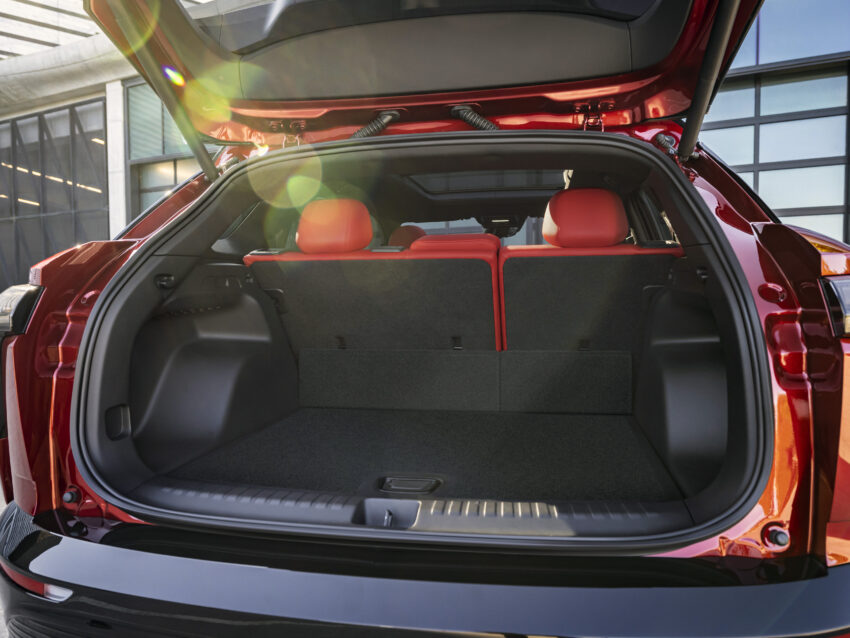
GM’s SuperCruise hands-free highway driving system is an option for the LT and RS trims, and will be standard on the SS.
The SS will get its own unique grille and most of the RS extras plus a high-performance, all-wheel drive electric powertrain with a boost function Chevy calls Wide Open Watts – or WOW – that boosts peak output to 557 horsepower and 648 pound-feet of torque for a Chevy-estimated 0-60 mph time of under 4 seconds. It also comes Brembo brakes up front, a sport-tuned chassis with a two-tone (black roof) exterior paint scheme, 22-inch alloys, heated rear outboard seats, sueded microfiber upholstery, a head-up display and digital camera rear-view mirror and SuperCruise.
Blazer EV Power
Chevrolet hasn’t made all the powertrain info available yet but what we do know is that the dual motors in the electronic all-wheel drive LT and RS trims produce a total of 288 horsepower while the single motor in the rear-drive RS is good for 340 hp.
The SS boasts a peak 577 horsepower and 648 pound-feet of torque for short bursts in WOW mode, but we don’t know yet what the horsepower and torque ratings are for the other 99% of the time.
To our dismay, we weren’t able to test the Blazer EV when it made its press debut in early December, so we’re relying on posted reviews from automotive scribes we trust for some of this information. We’ll update as necessary once we can get inside and behind the wheel.
Reviewers were generally in agreement that the dual-motor RS handles well but could use some more steering feedback. Chevy hasn’t posted any 0-60 mph times for the RS or LT, but Edmunds.com tested a dual-motor RS it bought for its long-term fleet and says it clocked a middle-of-the road 6.2 seconds. Chevy claims the SS will be able to turn in a sub-4-second time
There are several levels of regenerative braking, including one-pedal driving which can bring the Blazer EV to a full stop without use of the brake pedal.
Battery, Range and Charging
Battery capacity and range varies by trim level and powertrain configuration. Both LT versions get the base 85 kilowatt-hour battery pack, as does the all-wheel drive RS. The rear-drive RS and AWD SS get a larger 102 kWh pack for more power and range.
Chevy says the 2LT and RS trims with all-wheel drive will get an EPA estimated range of 279 miles while the rear-drive RS will be EPA-rated at 324 miles. Ratings for the front-drive LT haven’t been released yet.
Chevrolet has said it expects that the SS will come it at around 290 miles.
All Blazer EVs will be equipped with 11.5 kW on-bard chargers for Level 2 (240-volt) home and workplace charging. All trims also are capable of DC fast-charging at speeds of up to 190 kW per hour – fast enough to add almost 80 miles of range in 10 minutes, according to Chevrolet.
GM has said it is adopting the NACS charging system (from Tesla) for models introduced in 2025 and after. The Blazer EV is a 2024 introduction and has the CCS charging system so will need an adapter to use Tesla chargers. We don’t know yet whether 2025 models will be revamped for NACS.
[Learn all about EV charging.]
Safety Stuff
The Blazer EV also comes with a suite of advanced safety and driver assistance systems, including automatic high-beams forward collision alert, automatic forward emergency braking with pedestrian recognition, lane departure warning and lane keeping assist and automatic emergency braking in reverse to help avoid back-up accidents.
An optional Convenience and Driver Confidence package adds adaptive cruise control, intersection collision mitigation, rear collision sensing with automated braking, a surround-view camera system.
Inside the Blazer EV
The cabin reportedly is one of the quietest around, and the ride quite comfortable over all kinds of road surfaces, but the front seats could use some additional padding and bolstering.
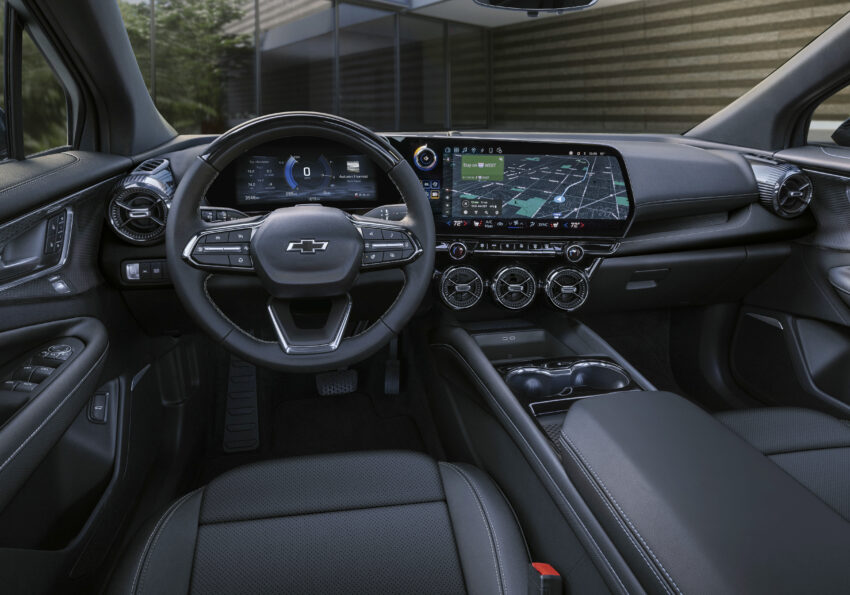
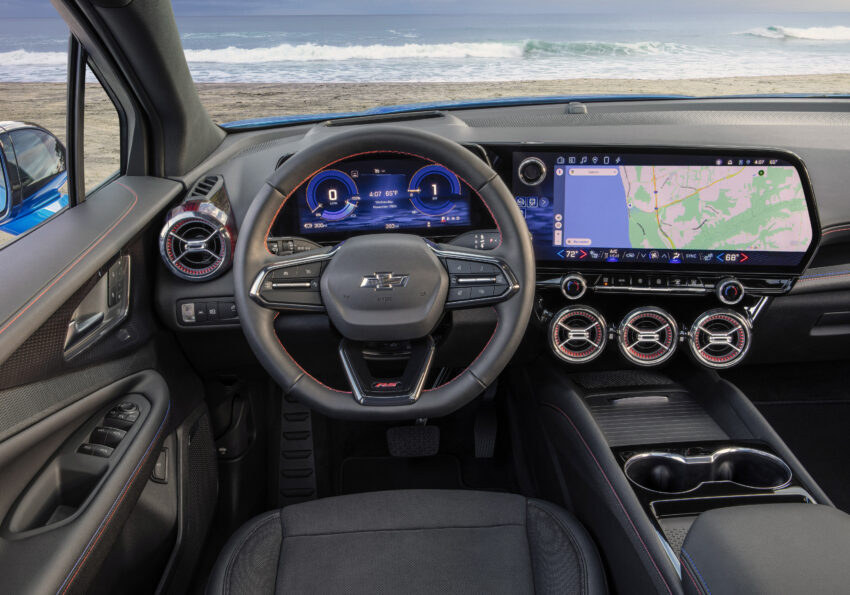
We’ll let Chevy-supplied photos detail the interior look, which – to our taste- is a bit of a mishmash of old-school and new.
Thanks to the Blazer EV’s long wheelbase, the interior is quite spacious, and the door openings nice and wide for easy ingress and egress. Rear legroom is especially generous.
There’s lots of room for carrying things in the Blazer EV – especially with the second-row seats folded flat, and the 60/40 split seats do fold pretty flat. There’s 25.5 cubic feet behind the second row – think two dozen standard grocery bags – with a lot of width but not a tremendous amount of depth. Drop the seats, though, and total cargo area swells to a very generous 59 cubic feet. There’s a smallish hidden cargo area under the floor, but fans of the frunk will be disappointed because there’s no storage under the hood.
If that’s not enough room, the Blazer EV is rated to tow up to a maximum of 1,500 pounds.
That Blazer EV Tech
A 17.7-inch infotainment screen and 11-inch driver info screens house controls for many of the Blazer EVs functions – including powering off, turning on the lights and setting one-pedal regenerative braking. Menus reportedly are well-organized and icons easy to see and understand.
But, as Chevrolet has discovered, moving controls to a touchscreen and abandoning physical controls such as dash-mounted buttons and knobs can present big problems if the operating software crashes.
There have been scattered reports of glitchy interface operation including screens going dark, windows refusing to operate and some cars refusing to accept a charge at public DC fast charge stations.
The most damning came from Edmunds.com, which purchased a Blazer EV for its longterm test fleet and in two months of ownership had multiple run-ins with software glitches, resulting in a reported two-plus weeks in a dealer’s service garage after a diagnostic check resulted in a rather alarming list of 23 error codes.
Now all Chevrolet’s got to do is fix the software and mount one heck of a PR campaign to persuade people they won’t get burned if they go for a Blazer EV.
(On a related note, the Cadillac Lyriq, which came out in 2022 as a ’23 model, shares the same platform and, apparently, some of the same electronics and software as the Blazer EV and has been racking up a long list of user complaints of software glitches on various owner sites including Cadillac Forums. An over-the-air update released just before Christmas seems to have resolved problems for many Lyriq owners, though.)
